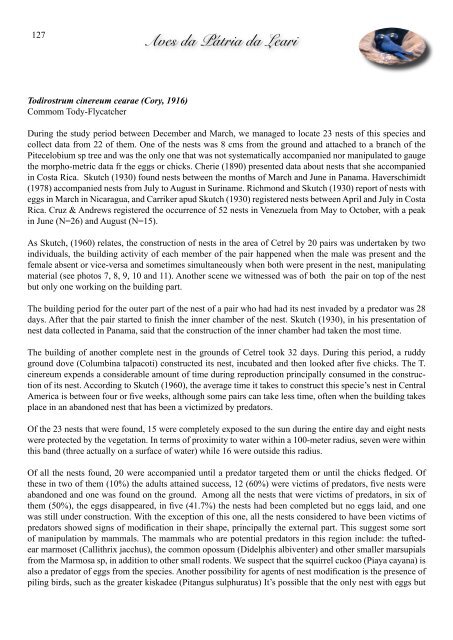Aves da Pátria da Leari - Sociedade Brasileira de Ornitologia
Aves da Pátria da Leari - Sociedade Brasileira de Ornitologia
Aves da Pátria da Leari - Sociedade Brasileira de Ornitologia
Create successful ePaper yourself
Turn your PDF publications into a flip-book with our unique Google optimized e-Paper software.
127<br />
Todirostrum cinereum cearae (Cory, 1916)<br />
Commom Tody-Flycatcher<br />
<strong>Aves</strong> <strong>da</strong> <strong>Pátria</strong> <strong>da</strong> <strong>Leari</strong><br />
During the study period between December and March, we managed to locate 23 nests of this species and<br />
collect <strong>da</strong>ta from 22 of them. One of the nests was 8 cms from the ground and attached to a branch of the<br />
Pitecelobium sp tree and was the only one that was not systematically accompanied nor manipulated to gauge<br />
the morpho-metric <strong>da</strong>ta fr the eggs or chicks. Cherie (1890) presented <strong>da</strong>ta about nests that she accompanied<br />
in Costa Rica. Skutch (1930) found nests between the months of March and June in Panama. Haverschimidt<br />
(1978) accompanied nests from July to August in Suriname. Richmond and Skutch (1930) report of nests with<br />
eggs in March in Nicaragua, and Carriker apud Skutch (1930) registered nests between April and July in Costa<br />
Rica. Cruz & Andrews registered the occurrence of 52 nests in Venezuela from May to October, with a peak<br />
in June (N=26) and August (N=15).<br />
As Skutch, (1960) relates, the construction of nests in the area of Cetrel by 20 pairs was un<strong>de</strong>rtaken by two<br />
individuals, the building activity of each member of the pair happened when the male was present and the<br />
female absent or vice-versa and sometimes simultaneously when both were present in the nest, manipulating<br />
material (see photos 7, 8, 9, 10 and 11). Another scene we witnessed was of both the pair on top of the nest<br />
but only one working on the building part.<br />
The building period for the outer part of the nest of a pair who had had its nest inva<strong>de</strong>d by a pre<strong>da</strong>tor was 28<br />
<strong>da</strong>ys. After that the pair started to finish the inner chamber of the nest. Skutch (1930), in his presentation of<br />
nest <strong>da</strong>ta collected in Panama, said that the construction of the inner chamber had taken the most time.<br />
The building of another complete nest in the grounds of Cetrel took 32 <strong>da</strong>ys. During this period, a ruddy<br />
ground dove (Columbina talpacoti) constructed its nest, incubated and then looked after five chicks. The T.<br />
cinereum expends a consi<strong>de</strong>rable amount of time during reproduction principally consumed in the construction<br />
of its nest. According to Skutch (1960), the average time it takes to construct this specie’s nest in Central<br />
America is between four or five weeks, although some pairs can take less time, often when the building takes<br />
place in an abandoned nest that has been a victimized by pre<strong>da</strong>tors.<br />
Of the 23 nests that were found, 15 were completely exposed to the sun during the entire <strong>da</strong>y and eight nests<br />
were protected by the vegetation. In terms of proximity to water within a 100-meter radius, seven were within<br />
this band (three actually on a surface of water) while 16 were outsi<strong>de</strong> this radius.<br />
Of all the nests found, 20 were accompanied until a pre<strong>da</strong>tor targeted them or until the chicks fledged. Of<br />
these in two of them (10%) the adults attained success, 12 (60%) were victims of pre<strong>da</strong>tors, five nests were<br />
abandoned and one was found on the ground. Among all the nests that were victims of pre<strong>da</strong>tors, in six of<br />
them (50%), the eggs disappeared, in five (41.7%) the nests had been completed but no eggs laid, and one<br />
was still un<strong>de</strong>r construction. With the exception of this one, all the nests consi<strong>de</strong>red to have been victims of<br />
pre<strong>da</strong>tors showed signs of modification in their shape, principally the external part. This suggest some sort<br />
of manipulation by mammals. The mammals who are potential pre<strong>da</strong>tors in this region inclu<strong>de</strong>: the tufte<strong>de</strong>ar<br />
marmoset (Callithrix jacchus), the common opossum (Di<strong>de</strong>lphis albiventer) and other smaller marsupials<br />
from the Marmosa sp, in addition to other small ro<strong>de</strong>nts. We suspect that the squirrel cuckoo (Piaya cayana) is<br />
also a pre<strong>da</strong>tor of eggs from the species. Another possibility for agents of nest modification is the presence of<br />
piling birds, such as the greater kiska<strong>de</strong>e (Pitangus sulphuratus) It’s possible that the only nest with eggs but

















